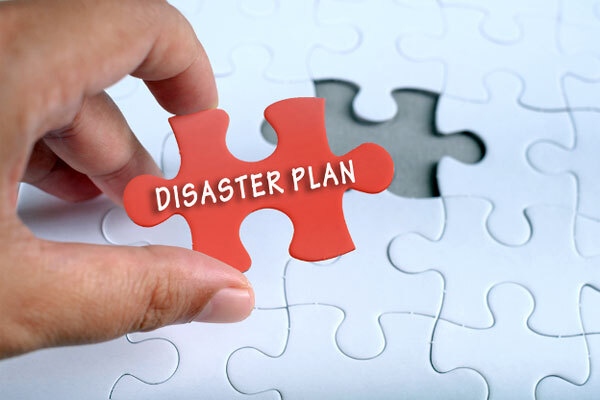 Disaster-proofing your records management program is critical to ensuring business continuity and records retention in the face of catastrophes and emergencies.
Disaster-proofing your records management program is critical to ensuring business continuity and records retention in the face of catastrophes and emergencies.
Yet government agencies are typically unprepared in this area, with only ad hoc and piecemeal strategies that make the process of protecting records against disasters unnecessarily complicated and difficult. To be fair, this isn’t entirely the fault of agencies themselves; years of changing regulations and judicial findings force near-constant tweaks. A review from the Government Accountability Office (GAO) found:
“[T]he federal approach to disaster recovery is fragmented across more than 30 federal entities. This approach is the product of over 40 years of incremental efforts to address emerging issues in disaster recovery through legislative reform as well as differing agency regulations and policies.”
Plus, the mandate to shift to primarily electronic records management (OMB/NARA M-23-07) has major implications for disaster preparedness. If the way agencies handle records is undergoing a major transition, so too will how they handle disaster and crisis preparation.
Here’s how to ensure your records management program is prepared for any future emergency or crisis situation.
First, Make Sure You Understand the Risks
The first step in disaster-proofing records management is understanding the risks specific to your organization and region. This includes natural disasters like floods, earthquakes, and hurricanes, as well as man-made threats such as cyberattacks and data breaches. These risks need to be assessed for their relative impact on all the different kinds of records used and stored by the agency. Plus, don’t discount simple human error: protecting against accidental deletions, misfiling, or improper handling of records must comprise a major element of any disaster preparedness and recovery plan. For government agencies, the risk assessment must also consider the potential for targeted attacks due to the sensitive nature of their data. That can include cyberattacks, data breaches, vandalism, and more.
Next, Develop a Comprehensive Disaster Recovery and Business Continuity Plan
Preparing for these risks involves not just physical safeguards but also robust digital security measures, regular backups, and comprehensive disaster recovery plans. For government agencies, this plan must align with federal or state regulations governing the storage, retention, and destruction of records. For example, this may mean ensuring records are accessible for public information requests, even in the aftermath of a disaster.
The GAO recommends several best practices in developing a disaster recovery plan. In general, these recommendations are meant to apply to the federal government as a whole, but many of them would equally apply to individual agencies trying to prepare for a disaster scenario.
- Prioritize disaster recovery funding. Often, disaster preparedness takes a back seat to more immediately pressing concerns. As a result, it is never allocated the budget or time needed to complete.
- Develop new efforts to communicate about recovery programs clearly and consistently. Communication is key to any recovery program; make sure all stakeholders are on the same page. Without internal coordination between teams and departments, any recovery program will struggle.
- Identify desired recovery outcomes and develop mechanisms to track. Then, stress-test the disaster recovery program to ensure it meets desired goals. A disaster recovery plan is only as good as its latest test.
Then, Invest in a Good Electronic Records Management (ERM) System
A good, high-performing ERM can be a tremendous asset in disaster recovery and business continuity. ERMs provide secure, off-site backups, which are less susceptible to physical damage compared to paper records. Even better, these backups can be quickly restored, maintaining the availability of essential information even when primary systems are compromised.
Moreover, ERM systems often incorporate advanced features like version control, audit trails, and encryption, which not only safeguard the integrity and confidentiality of records but also aid in tracking changes and accessing the correct versions of documents post-disaster. For help evaluating ERMs and choosing the right one for your needs, read our updated guide.
Finally, Promote Training and Awareness
Finally, employees should be educated about the importance of records management and trained in disaster response procedures. For government agencies, this training might also include handling classified or sensitive information during emergencies and stressing the importance of continuing to adhere to records management procedures even during disruptions or disasters. For example, a NARA investigation found “wide gaps” in records management protocols during disaster and disaster recovery events; some staff even questioned the need to follow records management protocols during disaster response and recovery events. Training can help close those people-related gaps in disaster preparedness and recovery.
In the end, disaster-proofing records management programs involves a blend of understanding risks, developing comprehensive plans, implementing redundant systems, and ensuring compliance with legal requirements. For government agencies, the stakes are even higher due to the sensitive nature of the information they handle and the legal mandates they must follow.
About PSL
PSL is a global outsource provider whose mission is to provide solutions that facilitate the movement of business-critical information between and among government agencies, business enterprises, and their partners. For more information, please visit or email info@penielsolutions.com.

